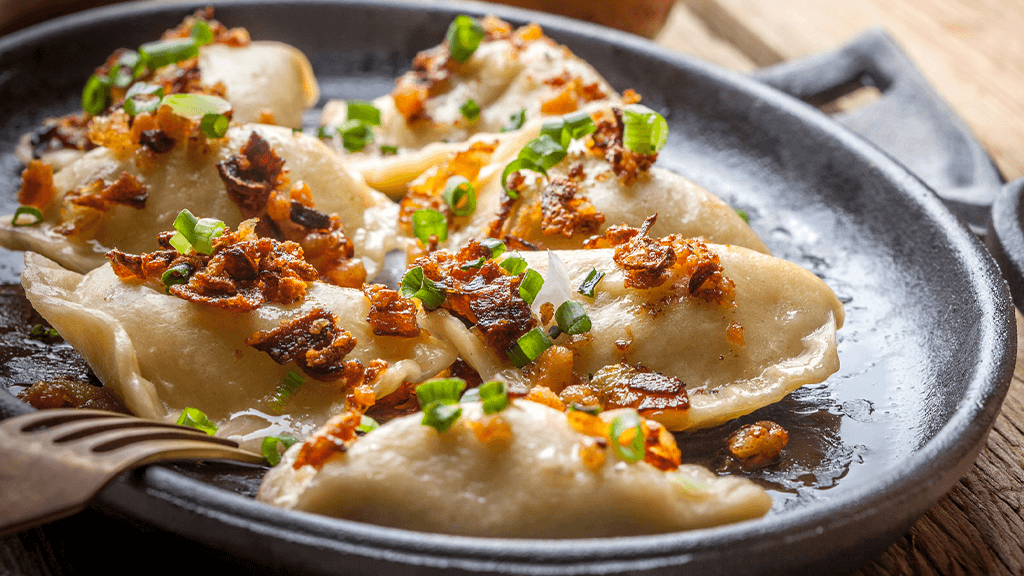Pierogies, the delicious doughy pockets filled with an array of ingredients, have long been a beloved staple in Eastern European cuisine. In this comprehensive guide, we will explore the history of pierogies, delve into their various components, and learn different cooking methods. So, prepare to expand your culinary knowledge and embark on a pierogi adventure!
What is a Pierogi?
A pierogi is a type of dumpling crafted from tender, unleavened dough, typically filled with ingredients such as potatoes, cheese, meat, or fruit. After sealing the dough, pierogies are cooked by boiling, frying, or baking. While often associated with Poland, pierogies’ origins can be traced to various cultures throughout history.
Origins and Cultural Significance
The exact origin of pierogies remains uncertain, but it’s believed that they arrived in Poland around the 13th century, possibly introduced by Saint Hyacinth, who brought them back from his travels to Kiev. Since then, pierogies have played an integral role in Polish cuisine and culture, especially during holidays and family gatherings.
Pierogies’ popularity extends beyond Poland, as they also feature prominently in the culinary traditions of countries such as Ukraine, Russia, Slovakia, and the Czech Republic, with each region offering its unique spin on these delectable dumplings.
What is a Pierogi Made Of?
Pierogies consist of two primary components: the dough and the filling. While traditional dough and filling recipes remain popular, modern variations cater to diverse tastes and dietary requirements.
Pierogi Dough
Pierogi dough is a simple mixture of flour, water, and salt, with some recipes also including egg or oil for added richness. The key to perfect pierogi dough lies in achieving the right balance of tenderness and elasticity, ensuring that it is easy to work with while remaining strong enough to hold the filling.
Pierogi Fillings
Pierogi fillings can be as diverse as the people who enjoy them. Here are some classic and contemporary fillings you may encounter:
Traditional Fillings
- Potato and Cheese: Known as “Ruskie pierogi” in Poland, this popular filling combines seasoned mashed potatoes with a soft, tangy cheese like farmer’s cheese or quark.
- Meat: A mixture of ground or finely chopped meats, such as pork, beef, or chicken, along with onions and spices, creates a hearty and flavorful filling.
- Sauerkraut and Mushrooms: This vegetarian option combines tangy sauerkraut with earthy mushrooms, often seasoned with black pepper and paprika.
Modern and Creative Fillings
- Dessert Fillings: Sweet pierogies are increasingly popular, featuring fillings such as stewed fruits, sweetened cottage cheese, or chocolate.
- Vegan and Vegetarian Pierogies: Plant-based variations include fillings like lentils, chickpeas, or seasoned tofu.
How to Cook Pierogies
Preparing and cooking pierogies involves three main steps: making the dough and filling, assembling the pierogies, and choosing a cooking technique.

Preparing the Dough and Filling
To make pierogi dough, combine flour, water, and salt in a large bowl, mixing until a soft and elastic dough forms. Knead the dough for several minutes before allowing it to rest. While the dough rests, prepare your chosen filling by combining the ingredients in a separate bowl.
Assembling Pierogies
- Roll out the rested dough on a lightly floured surface to a thickness of about 1/8-inch.
- Use a
- round cutter or a glass to cut circles of dough approximately 3 inches in diameter. 3. Place a spoonful of filling in the center of each dough circle, being careful not to overfill.
- Fold the dough over the filling to form a half-moon shape and press the edges firmly to seal, ensuring no filling escapes during cooking. You may also crimp the edges with a fork for added security and visual appeal.
Cooking Techniques
Once your pierogies are assembled, you can choose from several cooking methods to bring out their best flavors and textures:
- Boiling: The most traditional method, boiling pierogies involves cooking them in a pot of salted boiling water until they float to the surface, indicating they are cooked through. This usually takes 3-5 minutes.
- Pan-frying: For a crispier exterior, pan-fry boiled pierogies in a skillet with butter or oil over medium heat until golden brown on both sides.
- Baking: Preheat your oven to 350°F (180°C) and bake the pierogies on a parchment-lined baking sheet for 20-25 minutes, or until golden and crisp.
- Air frying: If you have an air fryer, cook the pierogies at 400°F (200°C) for 8-10 minutes, flipping halfway through for even browning.
Check out our perfect Polish pierogi recipe to try making these coal region classics on your own.
Serving and Pairing Pierogies
To fully enjoy your pierogies, consider traditional side dishes, accompaniments, and beverage pairings:
Side Dishes and Accompaniments
- Sour cream: A dollop of sour cream adds a cool, tangy contrast to the pierogi’s warm filling.
- Applesauce: A side of applesauce complements both sweet and savory pierogi fillings.
- Caramelized onions: Top your pierogies with caramelized onions for added sweetness and depth of flavor.
- Bacon bits: Crispy bacon bits provide a salty and savory crunch that pairs well with many pierogi fillings.
Beverage Pairings
- Beer: A light lager or pilsner helps cut through the richness of the pierogi, while a dark stout or porter can complement the robust flavors of meat-filled pierogies.
- Wine: White wines like Riesling or Grüner Veltliner pair well with pierogies, while red wines like Pinot Noir or Cabernet Franc can stand up to heartier meat fillings.
FAQ
How can I store leftover pierogies?
Cooked pierogies can be stored in the refrigerator for up to 3 days, or they can be frozen for up to 3 months. To reheat, either pan-fry or bake them until heated through and crisp.
Can I make pierogies ahead of time?
Yes, you can assemble pierogies ahead of time and store them in the refrigerator for up to 24 hours or freeze them for up to 3 months. Be sure to separate layers with parchment paper to prevent sticking.
Are there any gluten-free pierogi options?
Gluten-free pierogi dough can be made by substituting a gluten-free flour blend for the regular flour. Be sure to adjust the liquid content as needed to achieve the desired dough consistency.
Can pierogies be made vegan or vegetarian?
Absolutely! Pierogies can be adapted to suit vegan and vegetarian diets by using plant-based fillings and omitting eggs or dairy from the dough. Substitute vegan cheese, tofu, or other plant-based proteins for traditional filling ingredients.
Exploring Pierogi Culture
Pierogies are more than just a delicious food; they are a symbol of cultural identity and heritage for many Eastern European communities. To further immerse yourself in pierogi culture, consider attending pierogi festivals, exploring regional specialties, and incorporating these delightful dumplings into your family’s traditions and celebrations.
Regional Specialties
While the classic potato and cheese pierogi is perhaps the most widely recognized version, each region has its own unique spin on this versatile dish. Some regional specialties include:
- Lithuania: Koldūnai, small dumplings filled with meat, mushrooms, or fruit and often served with sour cream.
- Slovakia: Bryndzové pirohy, pierogies filled with a soft sheep cheese called bryndza and topped with bacon bits and chives.
Sampling regional specialties is an excellent way to expand your pierogi palate and appreciate the diversity of this humble yet delicious dish.
Pierogies in Family Traditions and Celebrations
In many Eastern European households, pierogies are a symbol of family, togetherness, and tradition. Families often gather to make pierogies from scratch, with each member participating in the process, from kneading the dough to sealing and cooking the dumplings. Pierogies also play a significant role in holiday celebrations, with specific types and fillings designated for special occasions like Christmas Eve, Easter, or weddings.
By incorporating pierogies into your family’s traditions and celebrations, you can create lasting memories and foster a sense of cultural pride and connection.
Subscribe to Coal Region Canary
Get email updates from Coal Region Canary by becoming a subscriber today. Just enter your email address below to get started!Support Coal Region Canary
Like our reporting and want to support truly local news in Schuylkill County? Your small donations help. For as little as $5, your contribution will allow us to cover more news that directly affects you. Consider donating today by hitting the big yellow button below ...


































